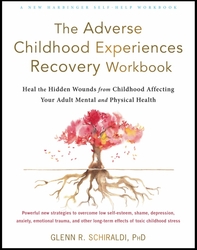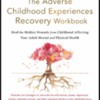Glenn R. Schiraldi, Ph.D. Psychology Today blog post, September 13, 2023
This post is part of a series on adverse childhood experiences. Read the other parts here.
Anxiety, including panic attacks, is now the most common psychiatric condition in the U.S., affecting nearly one in five adults, and prevalence rates are increasing worldwide. Often, anxiety seems to have a life of its own: it seems excessive and unreasonable; you don’t know where it’s coming from; and willpower doesn’t stop it. For many, adverse childhood experiences (ACEs) provide a clue. This article addresses solutions for this common problem.
1. Address the root cause.
Recall that attachment disruptions and other ACEs wire the brain to be on high alert. Unsettled, disturbing memories from childhood lodge in the non-verbal right brain, with its strong connections to the emotional and survival regions of the brain, often beneath conscious awareness. These memories continue to fuel anxiety until they are processed and settled.
Fortunately, many strategies developed in recent years can soothe and settle these memories. Some are self-managed and some are guided by specially trained trauma therapists (see, for example, Schiraldi 2021). In addition, the following skills can help.
2. Sit with the fear.
Often, we tense up and try to fight our worries, which increases stress arousal. Or we might try to flee our worries. But avoiding our fears (for example, through addictions, procrastination, etc.) merely provides temporary relief.
Mindfully sitting with your fears is a third, more effective option. Start by being aware of the breath. Breathe abdominally, low and slow, so that only your belly rises and falls as you breathe. (Stress-induced rapid, shallow breathing in the upper chest region often triggers anxiety and panic symptoms, so this is an important first step.)
Then without judging, create a space to allow the anxiety to be. With curious interest and acceptance, notice where in your body your experience the anxiety. Soften around that area. Then breathe compassion (or lovingkindness) into that area. Paradoxically, this approach can lessen anxiety without trying to do so.
3. Confide your fears.
Research has shown that simply writing the facts, feelings and thoughts related to your fears for 15-30 minutes on each of four days dramatically reduces symptoms and improves health and sleep. You can write about old hurts or you can write about present worries.
Write in a neutral place, like a table in a corner. Write only for yourself. If it gets overwhelming ease up. During the day, postpone your worries, knowing you can address them during your writing period.
4. Flow with panic attacks.
Should panic attacks occur, bracing and fighting them prolongs them. Panic attacks are simply stress responses “on steroids.” They typically run their course in 10-20 minutes, especially if you don’t fight them. Soften your body. Relax into, and flow with, the fear. Imagine that you are a reed bending with the wind.
5. Feed the gut microbiome.
People with anxiety tend to have an imbalance of microbes in the gut, which activates the brain’s fear center, increasing anxiety. The balance of good to bad microbes can be optimized with a Mediterranean-style diet, which emphasizes fiber-rich plant foods (vegetables, fruits, nuts, whole grains, seeds, beans) and healthy fats (from sources like fish and olive oil), while minimizing red meats and processed foods. (This type of eating also helps to reduce brain inflammation and oxidative stress that is often seen in anxiety.)
6. Hydrate.
Even mild dehydration can cause anxiety symptoms. Drink plenty of water throughout the day.
7. Consider taking a full-spectrum vitamin and mineral supplement.
Studies have found that supplements (one study looked at Centrum Silver, for example) can reduce anxiety and improve brain function. Turmeric is another supplement that can reduce anxiety.
8. Monitor your thyroid.
An overactive thyroid gland can make you feel anxious, like you are on caffeine, resulting in racing thoughts, sleep disruption, and other anxiety symptoms. Many people with this common problem are unaware of it or are not properly treated. Discuss this with your doctor.
9. Avoid caffeinated energy drinks.
Army research found that the regular consumption of energy drinks actually increased symptoms of anxiety, post-traumatic stress, fatigue, and disrupted sleep (Tobin et al., 2018).
10. Use tranquilizers cautiously.
Benzodiazepines, such as Xanax, Valium, Klonopin, and Ativan, are widely prescribed for anxiety. A new survey (Ritvo et al., 2023) revealed that long-term consequences occur during and after the use of benzodiazepines in the majority of people using them. These consequences include anxiety, sleep problems, trouble focusing, and disruptions in personal and work life.
Benzodiazepine use teaches no coping skills and discontinuation can be very difficult. Coping skills for anxiety can be just as effective, generally have no unpleasant side effects, and might enable you to minimize or avoid benzodiazepine use.
11. Move your body.
We’ve known for many years that exercise improves anxiety, depression, low self-esteem, and troubled sleep. Among its many benefits, exercise expends excessive stress energy and produces master molecules that helps the brain forge new, calmer neural pathways. So exercise is particularly beneficial for survivors of ACEs.
Even a ten-minute walk can help. Walking in the woods or near water can be especially calming. And don’t overlook tai chi, yoga, or qi gong.
12. Improve self-esteem.
At the University of Maryland, we found that low self-esteem and anxiety are highly correlated, and that self-esteem can be improved by applying sound principles and skills (Schiraldi, 2016).
13. Sleep well.
Regular, adequate, quality sleep is known to help regulate anxiety, promote positive memory storage, and reduce the intensity of negative memories. Most adults require 7-9 hours of sleep to feel and function at their best.
Try going to bed and getting up at the same times every day to strengthen sleep cycles. Dim lights 1-3 hours before retiring (especially blue lights), and block noise and light from entering the room.
14. Take action when possible.
You might try making a list of all the things you worry about. You might see that there are a handful of things, not an infinite number. Rank them from most to least concerning. Then go down the list, one at a time, and see what you can do to solve or improve them. Accept what you can and can’t do. “If you worry, you can’t do your best. If you are doing your best, why worry?”
Conclusion
Excessive anxiety is common, but need not be a lifelong sentence. Rather than increasing anxiety by fighting or fleeing it, try as best you can to kindly and patiently accept your fears, soothe and settle them, and then move on. Often, small changes in the way you approach your fears can reap large benefits.
References
- Schiraldi, G. R. (2021). The Adverse Childhood Experiences Recovery Workbook. Oakland, CA: New Harbinger.
- Schiraldi, G. R. (2016). The Self-Esteem Workbook. Oakland, CA: New Harbinger.
- Tobin, R. L., A. L. Adrian, C. W. Hoge, and A. B. Adler. (2018). “Energy Drink Use in U.S. Service Members After Deployment: Associations with Mental Health Problems, Aggression, and Fatigue.” Military Medicine 183: e364–e370.
- Ritvo, A. D., Foster, D. E., Huff, C., Finlayson, A. J. R., Silvernail, B., and Martin, P. R. (2023). Long-term Consequences of Benzodiazepine-induced Neurological Dysfunction: A Survey. PLoS ONE 18(6): e0285584. https://doi.org/10.1371/journal.pone.0285584.
About the Author
Glenn R. Schiraldi, PhD, has served on the stress management faculties at The Pentagon, the International Critical Incident Stress Foundation, and the University of Maryland, where he received the Outstanding Teacher Award in addition to other teaching/service awards. His fourteen books on stress-related topics have been translated into seventeen languages, and include The Adverse Childhood Experiences Recovery Workbook, The Self-Esteem Workbook. The Resilience Workbook, and The Post-Traumatic Stress Disorder Sourcebook. The founder of Resilience Training International (www.ResilienceFirst.com), he has trained laypersons, emergency responders, and clinicians around the world on the diverse aspects of stress, trauma, and resilience.
Title Image Photo credit: Ridofranz/istockphoto



Comments (0)